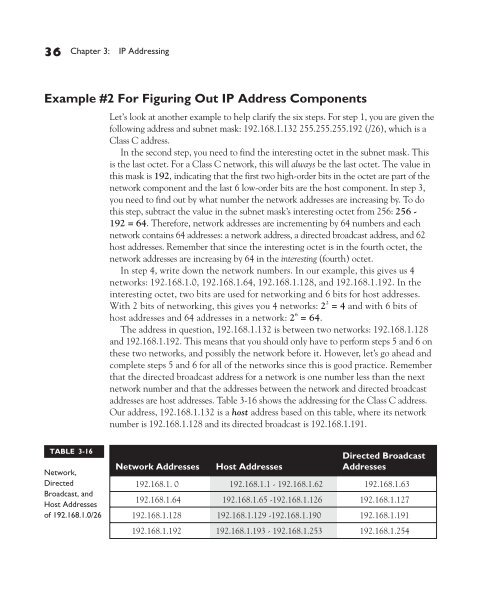ch03 IP Addressing.pdf - The Cisco Learning Network
ch03 IP Addressing.pdf - The Cisco Learning Network
ch03 IP Addressing.pdf - The Cisco Learning Network
You also want an ePaper? Increase the reach of your titles
YUMPU automatically turns print PDFs into web optimized ePapers that Google loves.
36 Chapter 3: <strong>IP</strong> <strong>Addressing</strong><br />
Example #2 For Figuring Out <strong>IP</strong> Address Components<br />
TABLE 3-16<br />
<strong>Network</strong>,<br />
Directed<br />
Broadcast, and<br />
Host Addresses<br />
of 192.168.1.0/26<br />
Let’s look at another example to help clarify the six steps. For step 1, you are given the<br />
following address and subnet mask: 192.168.1.132 255.255.255.192 (/26), which is a<br />
Class C address.<br />
In the second step, you need to find the interesting octet in the subnet mask. This<br />
is the last octet. For a Class C network, this will always be the last octet. <strong>The</strong> value in<br />
this mask is 192, indicating that the first two high-order bits in the octet are part of the<br />
network component and the last 6 low-order bits are the host component. In step 3,<br />
you need to find out by what number the network addresses are increasing by. To do<br />
this step, subtract the value in the subnet mask’s interesting octet from 256: 256 -<br />
192=64. <strong>The</strong>refore, network addresses are incrementing by 64 numbers and each<br />
network contains 64 addresses: a network address, a directed broadcast address, and 62<br />
host addresses. Remember that since the interesting octet is in the fourth octet, the<br />
network addresses are increasing by 64 in the interesting (fourth) octet.<br />
In step 4, write down the network numbers. In our example, this gives us 4<br />
networks: 192.168.1.0, 192.168.1.64, 192.168.1.128, and 192.168.1.192. In the<br />
interesting octet, two bits are used for networking and 6 bits for host addresses.<br />
With 2 bits of networking, this gives you 4 networks: 2 2 =4and with 6 bits of<br />
host addresses and 64 addresses in a network: 2 6 =64.<br />
<strong>The</strong> address in question, 192.168.1.132 is between two networks: 192.168.1.128<br />
and 192.168.1.192. This means that you should only have to perform steps 5 and 6 on<br />
these two networks, and possibly the network before it. However, let’s go ahead and<br />
complete steps 5 and 6 for all of the networks since this is good practice. Remember<br />
that the directed broadcast address for a network is one number less than the next<br />
network number and that the addresses between the network and directed broadcast<br />
addresses are host addresses. Table 3-16 shows the addressing for the Class C address.<br />
Our address, 192.168.1.132 is a host address based on this table, where its network<br />
number is 192.168.1.128 and its directed broadcast is 192.168.1.191.<br />
<strong>Network</strong> Addresses Host Addresses<br />
Directed Broadcast<br />
Addresses<br />
192.168.1. 0 192.168.1.1 - 192.168.1.62 192.168.1.63<br />
192.168.1.64 192.168.1.65 -192.168.1.126 192.168.1.127<br />
192.168.1.128 192.168.1.129 -192.168.1.190 192.168.1.191<br />
192.168.1.192 192.168.1.193 - 192.168.1.253 192.168.1.254

















